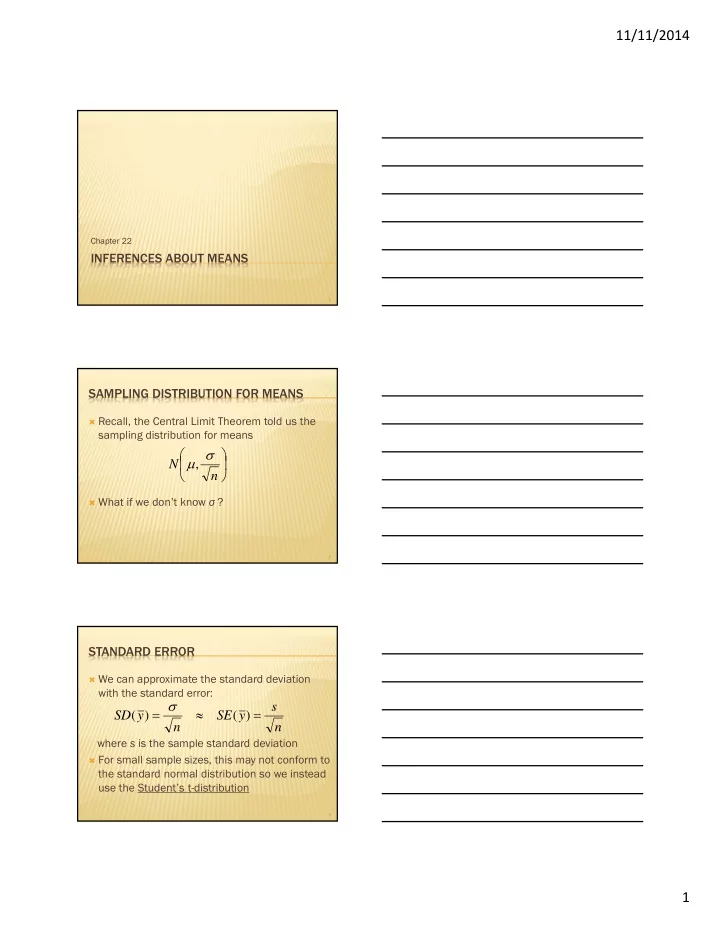

11/11/2014 Chapter 22 INFERENCES ABOUT MEANS 1 SAMPLING DISTRIBUTION FOR MEANS Recall, the Central Limit Theorem told us the sampling distribution for means , N n What if we don’t know σ ? 2 STANDARD ERROR We can approximate the standard deviation with the standard error: s SD ( y ) SE ( y ) n n where s is the sample standard deviation For small sample sizes, this may not conform to the standard normal distribution so we instead use the Student’s t-distribution 3 1
11/11/2014 STUDENT’S T-DISTRIBUTION The t-distribution is different for different sample sizes It has the same general symmetric bell-shape as a normal curve, but reflects greater variability (wider) Mean t = 0 Standard deviation varies with sample size, but is greater than 1 As n (sample size) gets larger, the t-distribution gets closer to the standard normal distribution 4 Retrieved from http://jpkc.njmu.edu.cn/course/tongjixue/file/jxzy/ybzzSD/images/fig14-2_0.jpg, March 29, 2010. 5 Retrieved from http://www.vosesoftware.com/ModelRiskHelp/images/13/image20.gif, March 29, 2010. 6 2
11/11/2014 DEGREES OF FREEDOM The number of degrees of freedom (df) for a single data set is the number of sample values that can vary after certain restrictions have been imposed on all data values For this application, df = n - 1 7 SAMPLING DISTRIBUTION FOR MEANS When the conditions are met, the standardized sample mean y t SE y follows a Student’s t -model with n – 1 degrees of freedom. We estimate the standard error with s SE y n 8 ASSUMPTIONS AND CONDITIONS Independence assumption Randomization 10% condition Normal population assumption Nearly normal condition: The data come from a distribution that is unimodal and symmetric. Check this condition by making a histogram or Normal probability plot. 9 3
11/11/2014 ONE-SAMPLE T -INTERVAL When the conditions are met, we are ready to find the confidence interval for the population mean, μ . The confidence interval is y t SE y 1 n where the standard error of the mean is s SE y n The critical value depends on the particular confidence level, t * n 1 C , that you specify and on the number of degrees of freedom, n – 1, which we get from the sample size. 10 ONE-SAMPLE T -TEST FOR THE MEAN The conditions for the one-sample t -test for the mean are the same as for the one-sample t -interval. We test the hypothesis H 0 : = 0 using the statistic y 0 t n 1 SE y The standard error of the sample mean is s SE y n When the conditions are met and the null hypothesis is true, this statistic follows a Student’s t model with n – 1 df. We use that model to obtain a P-value. 11 TESTING HYPOTHESES ABOUT A MEAN The three possible choices for hypotheses are: H 0 : μ = μ 0 , H A : μ ≠ μ 0 1. H 0 : μ = μ 0 , H A : μ < μ 0 2. H 0 : μ = μ 0 , H A : μ > μ 0 3. μ 0 is the null value 12 4
Recommend
More recommend